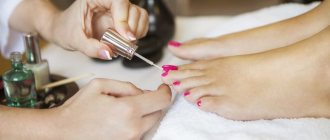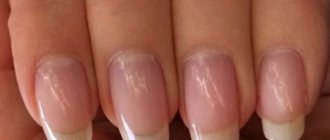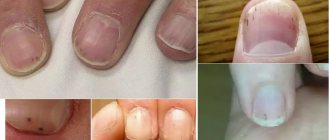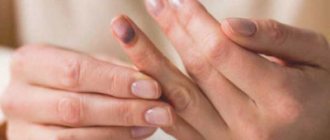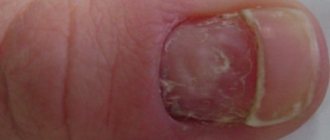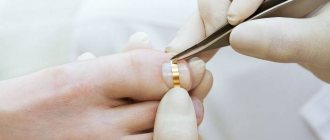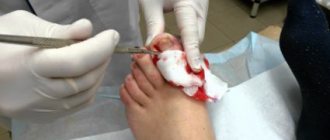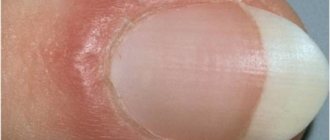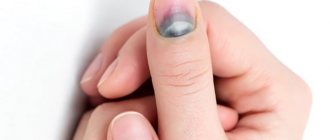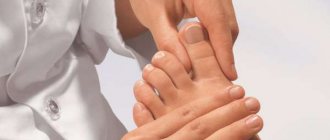16.04.2017
Nail fungus is a disease that can damage not only the nail plate, but also deep tissues if the disease is not treated for a long time.
In such a situation, the use of external antimycotic agents will not be effective - the affected nails will need to be removed. Doctors consider nail plate removal a last resort when treatment does not produce the desired results.
It is recommended to remove the nail for the following types of fungus:
- normotrophic – characterized by a change in the color of the nail plate;
- hypertrophic – characterized by thickening of the nail, making walking difficult;
- atrophic - the nail plate begins to separate from the bed, the color of the nail becomes brown.
All advanced forms of fungal infection are difficult to treat. More often, this form of the disease is diagnosed in older people and people with weak immune systems. Against the background of varicose veins, taking hormonal drugs and antibiotics, the disease actively progresses. Modern anti-fungal tablets taken orally have side effects and are difficult to tolerate by the liver and kidneys. It is not advisable for weakened people to use this method; in their case, the solution is surgical removal of the nail or choosing another procedure - nails can be removed with a laser, chemicals, or hardware pedicure machines.
Only a doctor can prescribe a method for removing a nail; nail removal is carried out taking into account the presence of concomitant diseases, contraindications, the patient’s age and other significant factors.
Surgical nail removal
They began to cut off the nail under local anesthesia a long time ago. You can cut off only part of the plate if the fungus has not spread to the entire nail, or the entire plate will be removed if the disease often recurs and the fungus has captured a large area. Before the operation, the doctor will review your medical history. Contraindications to the surgical method are: lameness, poor blood supply to the capillaries, low oxygen levels in the blood.
The doctor will remove the nail under local anesthesia. The injection is made into the finger, after which part of the nail or the entire plate is removed.
After surgery, an antibiotic is applied to the wound and a sterile dressing is applied. The patient will have to come back for dressing changes every other day. The wound heals in about a month, and a new nail will grow in 6-18 months.
Finger hurts after nail removal
Separation of the nail plate, like any operation, is associated with subsequent pain. Depending on the condition of the finger, prior to surgery, pain can be felt on average for up to ten days.
To make this time easier, you can take prescribed painkillers.
Swelling after nail removal
An operation, even a minor one, causes tissue damage; in response, the body begins a recovery process - a slight swelling is considered normal.
However, if the finger is very swollen, you should urgently visit your doctor to avoid complications. You should also come in for an examination if your foot, leg, or hand has swelling on the finger from which the nail was removed.
An ingrown nail or onychocryptosis is the ingrowth of a part of the nail plate into the lateral edge of the nail fold tissue. The outer edge of the big toe is most often affected. When an ingrown nail occurs, the nail fold turns red, swells, and an inflammatory process occurs, which is accompanied by severe pain.
Not everyone notices that the nail has grown into the skin, and consult a doctor already at the stage of suppuration and unbearable pain. In half of the cases, an ingrown toenail becomes a chronic phenomenon.
Medical (hardware) pedicure
For those who are thinking about how to remove a nail affected by fungus without pain and suffering, a hardware pedicure is suitable. The procedure is carried out not in beauty salons, but in medical offices. The specialist must have a medical education. The nail is removed carefully using a machine with attachments. There is no pain. After the procedure, ointment is applied to the wound and a bandage is secured. Before you start cutting off the nail with attachments, the plate is softened with special compounds and disinfected.
Machines for hardware pedicure are offered for free sale on the Internet. However, trying to remove a nail with fungus at home is not recommended - without experience and sterile conditions, you can only achieve the spread of the infection to other nails, blood contamination with bacteria, etc. When contacting the clinic, you can expect that:
- hardware pedicure will be painless;
- the rehabilitation period is minimal;
- the new nail will grow straight;
- It is enough to choose the right means for removing a nail affected by fungus and perform the procedure correctly to forget about the problem.
Consequences of self-removal of the nail that you should know about
Wanting to save time and money, patients with onychomycosis decide to remove the nail plate themselves at home.
To ensure the procedure is successful, use the following tips:
- do not allow the wound surface to get wet;
- change dressings on time, maintain sterility;
- use painkillers and antibacterial drugs;
- eliminate physical stress on the leg;
- wear comfortable shoes, protect your finger from injury;
- do not visit saunas, baths;
- Do not allow hypothermia or contact with running water on your finger.
Even following these simple recommendations, the postoperative period is accompanied by the following risks:
- re-infection;
- pain;
- deformation of the new plate due to injury to the growth zone.
Removing the plate at home by patients with diabetes mellitus and diseases of the cardiovascular system is fraught with purulent inflammation and gangrene.
It is recommended that the nail removal procedure be performed by specialists in a medical office or sterile operating area. The doctor will conduct a diagnosis, prescribe an operation taking into account contraindications, and further therapy. An operation performed by professionals will protect you from complications.
Laser removal of nails with fungus
Laser treatment of nail fungus has become an excellent alternative to surgery. Laser equipment is characterized by precise operation, targeting only fungal spores, without damaging tissues and nails. The procedure takes about half an hour. To completely cure the fungus, you will need about 6 procedures at a certain interval. Before removing a nail affected by a fungus using a laser, the doctor will order a urine and blood test, isolation of the causative agent, and an ultrasound. After laser therapy is completed, tests are repeated to ensure successful removal of the fungus.
The day before the procedure, the nails are steamed in a bath with hot water, soda and laundry soap. After this, your nails need to be trimmed short. The laser is contraindicated for pregnant women, breastfeeding women, and children. Also, laser therapy for onychomycosis is not performed for patients with oncology, epilepsy, or diabetes.
Matrixectomy as a way to remove nails with fungus
The nail matrix is the germinal epithelium that forms the nail plate through continuous differentiation from basal cells.
Matrixectomy is the process of destroying the nail matrix. This prevents the restoration of a new nail plate. This method of nail removal for fungus, ingrown toenails, chronic nail dystrophy and other conditions should be considered only after all traditional treatment methods, including partial or complete tearing of nails, have failed.
- Once the decision to perform a matrixectomy has been made, most often a partial procedure is performed (removal of the infected portion of the matrix while attempting to preserve the central portion of the nail plate). This helps maintain the normal structure and function of the nail plate.
- Total matrixectomy is “reserved” for cases of chronic or acute nail dystrophy, especially when the disease has become refractory to several different treatment attempts.
Matrixectomy can be performed surgically, chemically, or electrically. Ablative (with violation of the integrity of the skin) matrixectomy involves cauterization with a chemical substance, the use of electrocoagulation or a laser to destroy the nail matrix. An excisional (removal of the entire lesion) matrixectomy to remove nail fungus uses a surgical scalpel, electrosurgery, or a laser incision to remove the matrix.
Risks associated with the procedure:
- Severe pain in the postoperative period.
- Long-term healing.
Ointments and creams for nail fungus
In addition to the above procedures, you can find a remedy for removing nails affected by fungus at home. Special ointments or creams contain urea, an antiseptic, stearic acid and an antifungal agent.
Popular ointments that can remove diseased nails are: nogticin, mycospor, nogthemycin. The procedure is not complicated - you need to steam your nails in a soap and soda bath, then clean the surface of the nail with a nail file. In order not to damage the areas of skin around the nail affected by the fungus, they are sealed with a band-aid.
Next, all that remains is to apply ointment to the damaged nail, stick a patch on top, and leave for 3-4 days (as stated in the instructions). After the required time, the patch is removed, the nails are steamed, and the damaged areas are removed. The procedure is repeated as many times as necessary until the nail is completely removed.
It is worth noting
As for treatment, its results can be discouraging. Creams, varnishes and lotions often do not penetrate deep enough under the nail and are therefore ineffective.
Oral antifungal nail medications have better results but may cause stomach problems and, less commonly, liver damage. They need to be taken for several weeks and sometimes months.
The best way to get rid of fungus permanently is a minor operation to remove the nail, which many doctors will do under local anesthesia.
Varnishes against fungus
A varnish with keratolytic properties has a complex effect on diseased nails - it is used to remove nails affected by fungus, as well as to prevent onychomycosis. The advantage of varnish is the accuracy of application and ease of use. The disadvantage is the high price.
The most popular varnishes are: batrafen, micosan, loteryl. The procedure is simple and straightforward - first, the nails are steamed in a bath with soda and soap, then cut short. Use a disposable nail file to clean the nail plate, after which a thin layer of varnish is applied according to the instructions for the product. Once a week, the nails are steamed, then the affected part of the nail is filed off.
Symptoms of an ingrown toenail
Swelling, pus and inflammation are the first signs of ingrowth
The first symptom of the disease is a painful sensation that causes discomfort of varying severity in the area of the nail fold. The development process begins with mild discomfort, not pain, while walking. Gradually, if you do not pay attention to them, the pain intensifies, and an ulcer appears in the inflamed area of the nail fold. Subsequently ignoring the problem leads to infection in the wound and the appearance of purulent discharge. It all ends with the growth of pathological granulation, namely the appearance in the affected area of tissues called “wild meat”. This means that the disease has entered the chronic phase.
In the future, the ingrown nail piece will begin to complicate a person’s life, and moving will be even more uncomfortable. Even in the early stages, it is recommended to consult a doctor for advice and a correct diagnosis. Inflammation of the nail fold can develop as an independent disease not only as a result of injury or wearing uncomfortable shoes. This may be the result of changes in the body caused by diabetes or other serious illness.
Folk remedies for removing nails
For those who find pharmaceutical products expensive or unsafe, traditional medicine recipes can be recommended. Despite their variety, the essence is the same - to soften the diseased nail so that it is easier to remove later. Folk remedies can be used instead of pharmaceutical creams and plasters, but it is important to maintain hygiene - use antiseptics and ointments for fungus so as not to spread the infection further.
The simplest and cheapest way to soften a nail is to steam it in a hot bath and then treat it with birch tar. The water for the bath should be very hot; a few drops of tea tree oil are added to it for disinfection.
Tar is sold at the pharmacy. After steaming and drying the nails, tar is applied to them, wrapped in film, and socks are put on top. In the morning the tar is washed off. This is repeated until the nail moves away from the bed, giving way to a new, healthy nail.
After removing the nail, seal the wound with a breathable adhesive plaster, do not forget to continue treatment with antifungal drugs, and maintain hygiene. By following all the recommendations of your doctor, you can quickly get rid of the fungus and prevent its reappearance.
What to apply to the nail after removal
Often the process of removing the nail plate is associated with an inflammatory process, so doctors prescribe dressings with the drug Levomekol or Levosin.
- Dressings after nail removal are carried out daily, once a day until the wound is completely healed, when a dense film forms in place of the nail.
Before handling, be sure to wash your hands with antibacterial soap. During the dressing process, the old sterile bandage and ointment swab are removed from the wound.
Next, the wound is washed with chlorhexedine or hydrogen peroxide (a drug recommended by your doctor), after which the wound is left to dry for a minute.
Then the recommended ointment is applied (to the wound or tampon), followed by a dry sterile dressing and bandage.
Will the nail grow back after removal?
The answer to this question most often worries women, because without a nail plate, even on one finger, the general perception of the hand or foot changes.
Surgery to remove the nail plate is a priority only in the case of severe inflammation in the finger; in other situations, a less traumatic treatment is preferable.
